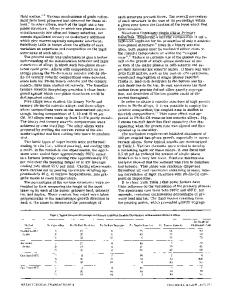The Formation of Epitaxial Eutectic Modulated Structures
- PDF / 248,452 Bytes
- 6 Pages / 414.72 x 648 pts Page_size
- 94 Downloads / 368 Views
THE FORMATION OF EPITAXIAL EUTECTIC MODULATED STRUCTURES ALEXANDER L. ROYTBURD and GISUK SUNG Department of Materials and Nuclear Engineering University of Maryland, College Park, MD20742-2115
ABSTRACT The thermodynamics of the formation of a coherent epitaxial two-phase modulated structures from a liquid solution is considered. It is shown that elastic interactions in the epitaxial system change the topologic features of the eutectic phase diagram. As a consequence an eutectic point splits into two eutectic points or it is transformed into a consolute point. INTRODUCTION In this paper the thermodynamic theory of heterophase modulated structures in epitaxial layers [1,2] will be applied to an epitaxial crystallization of an eutectic binary alloy. The case of complete non-solubility of the solid components will be considered as an example. For this case, the phase equilibria are described by a well-known eutectic diagram (Fig. 1). The equilibrium coherent two-phase system in an epitaxial layer has a structure of alternating plane-parallel lamellas dependent on the average composition of the alloy with a relative thickness as shown in Fig. 1. We will show that elastic interactions between the phases result in a dramatic change of the phase diagram; not only are the lines of the diagrams shifted, but the topology of the diagram changes as well. FREE ENERGY OF A COHERENT TWO-PHASE MIXTURE IN AN EPITAXIAL LAYER As shown before, the free energy of alternating plane-parallel layers of a coherent twophase system which keeps the epitaxial contact with a substrate is as follows [1,2] A12 =
(1- a)fi + cf2 - a(i - a)el 2 = (1- a)(fj + ei) +a(f2 + e2) - a(i - c)e, 2 (1)
where a is a volume fraction of phase 1 or a relative thickness of a layer of phase 1, fl and f2 are the free energies of the individual epitaxial phases 1 and 2 respectively, and e 12 is the interaction energy between the phases. The free energy, f, (or f2) consists of the chemical free energy of the undistorted phase, f{' (or f2), and the elastic energy, el (or e2), due to the epitaxy on the substrate. These elastic energies are determined by the misfits between the phases and the substrate and by the elastic properties of the phases. The energy e 12 is a result of direct and indirect (through the substrate) elastic interactions between the phases. Depending on the ratio of the energies of these interactions, e 12 can be positive or negative when the thickness of the epitaxial layer is large enough. If e 12 > 0 at large thicknesses, the energy e 22 can change its sign and becdme negative as the thickness becomes smaller than the critical thickness. The free energy of the two-phase epitaxial layer, f12 as a function of the fraction a, is described by the concave or the convex curves depending on the sign of e 12 (Fig. 2). In the case of non-solubility in the solid state, ff' and f•' are the free energies of the undistorted solid components and do not depend on concentrations. Therefore, the dependence of the free energy on a is equivalent to its dependence o
Data Loading...










